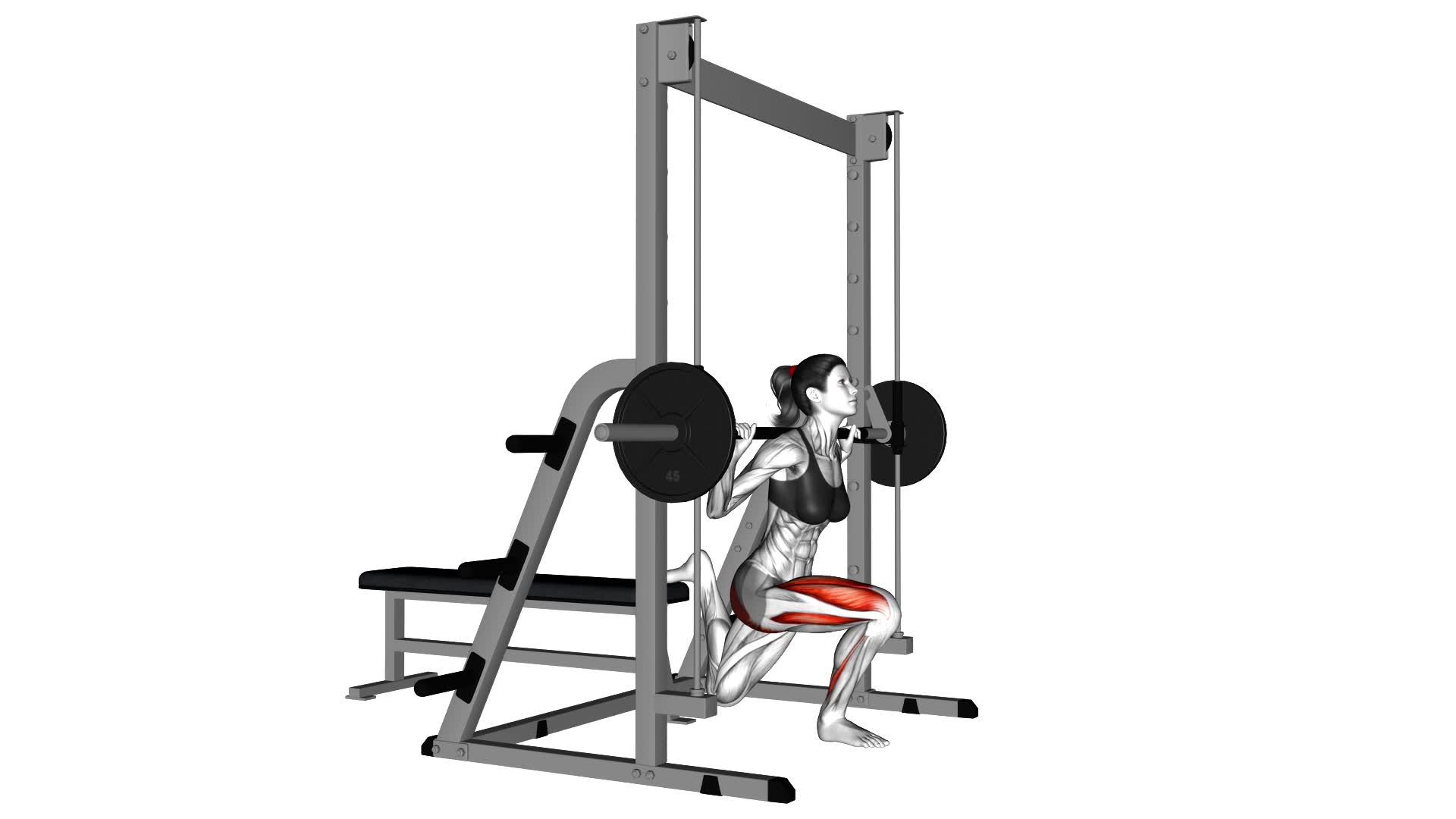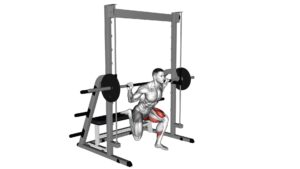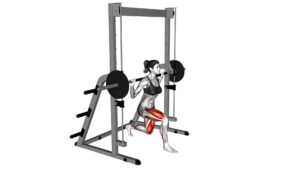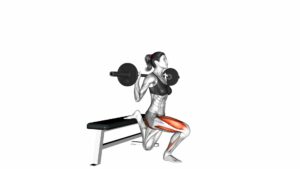Smith Single Leg Split Squat (female) – Video Exercise Guide & Tips

Are you looking for a challenging lower body exercise that targets your glutes and quads? Look no further than the Smith Single Leg Split Squat.
Watch This Exercise Video
In this video exercise guide, we'll show you proper form, modifications for beginners, and advanced variations for experienced lifters.
We'll also discuss common mistakes to avoid and provide tips for maximizing your results.
Get ready to amp up your leg workout with the Smith Single Leg Split Squat!
Key Takeaways
- The Smith Single Leg Split Squat targets multiple muscle groups including the glutes, quads, hamstrings, and calves.
- This exercise improves lower body strength and stability while also correcting muscle imbalances.
- It activates multiple muscle groups simultaneously, making it a efficient and effective exercise.
- The Smith Single Leg Split Squat enhances balance and coordination, making it a valuable addition to any workout routine.
Benefits of the Smith Single Leg Split Squat
Discover the benefits of the Smith Single Leg Split Squat for improving lower body strength and stability.
This exercise is a great way to target your quadriceps, hamstrings, glutes, and calves, all while challenging your balance and stability.
One of the key benefits of the Smith Single Leg Split Squat is that it provides an alternative to traditional squats and lunges, allowing you to work each leg independently. This can help to correct any muscle imbalances you may have and improve overall lower body strength and stability.
Additionally, the Smith Single Leg Split Squat activates multiple muscle groups simultaneously, making it a highly efficient exercise. By engaging your core, you can further enhance the stability and strength of your lower body.
Incorporating this exercise into your routine can also help to improve your balance and coordination, as you're required to maintain control throughout the movement.
Proper Form and Technique
To perform the Smith Single Leg Split Squat with proper form and technique, focus on maintaining a stable and balanced position throughout the exercise. This will help maximize your results and prevent common mistakes.
Start by standing with your feet shoulder-width apart and place one foot slightly in front of you on a bench or step. Position the barbell on your shoulders behind your head, gripping it with an overhand grip.
Engage your core and keep your upper body upright throughout the movement. Lower your body by bending your knees, ensuring that your front knee stays in line with your toes and doesn't extend past your toes.
Keep your back straight and avoid rounding or arching it. Aim to lower your back knee until it's just above the ground, then push through your front heel to return to the starting position. Repeat on the other leg.
Modifications for Beginners
If you're a beginner, you can modify the Smith Single Leg Split Squat to accommodate your fitness level. This exercise can be challenging, but with the right modifications, you can gradually progress and build strength.
To start, you can perform the split squat with both feet on the ground instead of elevating one foot on a bench or step. This will provide more stability and make it easier to maintain proper form. As you become more comfortable, you can progress to elevating one foot on a low step or bench.
Another modification option is to use a lighter weight or no weight at all. This will reduce the intensity and allow you to focus on mastering the movement pattern before adding resistance. As you get stronger, you can gradually increase the weight.
Additionally, you can start by performing fewer repetitions and sets. Aim for 8-10 reps on each leg for 2-3 sets, and gradually increase the volume as you progress.
Remember to listen to your body and only progress when you feel ready. By starting with these beginner modifications and gradually adding progression options, you can safely and effectively build strength with the Smith Single Leg Split Squat.
Advanced Variations for Experienced Lifters
Try incorporating these advanced variations of the Smith Single Leg Split Squat to challenge your strength and take your workout to the next level. These advanced modifications are designed for experienced lifters who are looking to intensify their training and push their limits.
Here are four intensity techniques you can use to maximize your results:
- Weighted Smith Single Leg Split Squat: Hold a dumbbell or kettlebell in one hand while performing the exercise. This added resistance will increase the demand on your muscles and enhance your overall strength.
- Plyometric Smith Single Leg Split Squat: Instead of performing a regular split squat, explode off the ground during the concentric phase, switching the position of your legs mid-air. This explosive movement will engage more muscles and elevate your heart rate, making it a great option for cardio and power development.
- Elevated Smith Single Leg Split Squat: Place your back foot on an elevated surface, such as a step or weight plate. This modification will increase the range of motion and target your glutes and hamstrings more effectively.
- Unilateral Smith Single Leg Split Squat: Instead of using both legs, perform the exercise with only one leg at a time. This unilateral variation will challenge your stability and balance, engaging your core muscles even more.
Incorporating these advanced variations into your Smith Single Leg Split Squat routine will keep your workouts challenging and exciting.
Now, let's move on to the next section about common mistakes and how to avoid them.
Common Mistakes and How to Avoid Them
To ensure that you perform the Smith Single Leg Split Squat correctly and avoid common mistakes, it's important to pay attention to proper form demonstration. This will help you understand the key alignment cues and ensure that you maintain the correct posture throughout the exercise.
If you're a beginner, there are also modification options available to gradually build up your strength and stability.
Proper Form Demonstration
To demonstrate proper form for the Smith Single Leg Split Squat (female), focus on maintaining a stable position and avoiding common mistakes. Here are four key tips to help you achieve a successful squat:
- Keep your front knee aligned with your ankle to prevent it from caving inwards, which can put unnecessary strain on your knee joint.
- Engage your core and glutes throughout the movement to maintain balance and stability.
- Ensure your back knee isn't touching the ground, as this will take away the activation from your front leg.
- Maintain an upright posture with your chest lifted and shoulders back to avoid rounding your back and placing strain on your spine.
By following these tips, you'll be able to perform the Smith Single Leg Split Squat with proper form and maximize the benefits of the exercise.
Now, let's move on to the next section and explore key alignment cues.
Key Alignment Cues
Maintain proper alignment during the Smith Single Leg Split Squat to avoid common mistakes and maximize the effectiveness of the exercise.
To ensure correct form, start by positioning yourself in front of the Smith machine with your back facing it.
Place one foot about two to three feet in front of the other, with your toes pointing forward.
As you lower your body into the squat, keep your front knee aligned with your ankle, making sure it doesn't go past your toes.
Engage your core and keep your back straight throughout the movement. Avoid leaning forward or hunching your shoulders.
By following these alignment cues, you can ensure that you're maximizing your results and targeting your leg muscles effectively.
Now, let's explore modification options for beginners.
Modification Options for Beginners
Avoiding common mistakes is crucial for beginners when performing the Smith Single Leg Split Squat. To ensure you have a successful workout, here are some modification techniques and common beginner mistakes to avoid:
- Start with a higher bench or step: If you find it challenging to maintain balance or perform the exercise with proper form, use a higher bench or step to decrease the range of motion.
- Use a lighter weight: It's better to focus on correct form and gradually increase the weight as you become more comfortable with the movement.
- Maintain proper alignment: Keep your chest lifted, shoulders back, and core engaged throughout the exercise. Avoid leaning forward or letting your knee collapse inward.
- Use a support: If needed, hold onto a stable object or use a resistance band for assistance while performing the exercise.
By following these modification techniques and avoiding common beginner mistakes, you can ensure a safe and effective workout.
Now, let's dive into some tips for maximizing your results.
Tips for Maximizing Results
Are you wondering how to get the most out of your Smith Single Leg Split Squat (female) workout? Maximizing your results is important to achieve the desired benefits from this exercise. To help you in this process, it's essential to avoid common mistakes that can hinder your progress.
One common mistake isn't maintaining proper form and alignment. Make sure your front knee stays directly above your ankle and doesn't go past your toes.
Another mistake isn't engaging your core muscles. Remember to brace your core and keep your back straight throughout the movement.
Additionally, it's important to focus on using the correct weight or resistance. Start with a weight that challenges you but still allows you to maintain proper form. As you progress, you can gradually increase the weight or try advanced variations such as adding dumbbells or using a stability ball. These variations will further challenge your muscles and help you achieve better results.
Frequently Asked Questions
How Many Sets and Reps Should I Do for the Smith Single Leg Split Squat?
To get the most out of the Smith Single Leg Split Squat, it's important to know the recommended sets and reps. The number of sets and reps will depend on your fitness level and goals. Generally, it's recommended to start with 2-3 sets of 8-12 reps per leg.
This exercise not only targets your quads, glutes, and hamstrings, but also improves balance and stability. Remember to consult with a fitness professional for personalized advice and variations for the Smith Single Leg Split Squat.
Can the Smith Single Leg Split Squat Help With Improving Balance and Stability?
Improving balance and stability can be achieved through the Smith Single Leg Split Squat. This exercise targets your leg muscles, core, and stabilizer muscles, which are essential for maintaining balance.
By performing this exercise, you challenge your muscles to stabilize your body while balancing on one leg. This helps improve your overall balance and stability, making everyday activities easier and reducing the risk of falls or injuries.
Incorporating the Smith Single Leg Split Squat into your workout routine can be beneficial for enhancing your balance and stability.
Is It Necessary to Use the Smith Machine for This Exercise, or Can I Use Free Weights?
Using free weights for the single leg split squat offers several benefits. It requires more stability and engages the core muscles to a greater extent. Additionally, free weights allow for a greater range of motion and promote functional strength.
However, it's important to choose weights that are appropriate for your fitness level to avoid injury. There are also variations of the single leg split squat that can be modified for different fitness levels, such as using a bench for support or adding resistance bands for added challenge.
Are There Any Specific Muscle Groups That the Smith Single Leg Split Squat Primarily Targets?
The Smith single leg split squat primarily targets your quadriceps, hamstrings, glutes, and calves. It's a great exercise for strengthening and toning these muscle groups.
Variations of this exercise include using dumbbells or a barbell for added resistance. Incorporating the Smith machine allows for stability and control throughout the movement.
Performing this exercise regularly can improve lower body strength, stability, and balance.
Can the Smith Single Leg Split Squat Be Used as a Substitute for Traditional Squats in a Workout Routine?
Yes, the Smith single leg split squat can definitely be used as a substitute for traditional squats in your workout routine. This exercise is great for targeting your glutes, quads, and hamstrings, just like traditional squats.
Plus, incorporating single leg exercises into your routine has additional benefits, such as improving balance, stability, and core strength.
There are also variations of split squats that can target different muscle groups, allowing you to customize your workout to meet your specific goals.
Conclusion
In conclusion, the Smith Single Leg Split Squat is a highly effective exercise for targeting the lower body muscles, especially the quads, glutes, and hamstrings. By maintaining proper form and technique, individuals can maximize their results and avoid common mistakes.
Beginners can modify the exercise to suit their fitness level, while experienced lifters can try advanced variations to challenge themselves further.
Incorporating this exercise into a workout routine can lead to improved strength, stability, and overall lower body fitness.

Author
Years ago, the spark of my life’s passion ignited in my mind the moment I stepped into the local gym for the first time. The inaugural bead of perspiration, the initial endeavor, the very first surge of endorphins, and a sense of pride that washed over me post-workout marked the beginning of my deep-seated interest in strength sports, fitness, and sports nutrition. This very curiosity blossomed rapidly into a profound fascination, propelling me to earn a Master’s degree in Physical Education from the Academy of Physical Education in Krakow, followed by a Sports Manager diploma from the Jagiellonian University. My journey of growth led me to gain more specialized qualifications, such as being a certified personal trainer with a focus on sports dietetics, a lifeguard, and an instructor for wellness and corrective gymnastics. Theoretical knowledge paired seamlessly with practical experience, reinforcing my belief that the transformation of individuals under my guidance was also a reflection of my personal growth. This belief holds true even today. Each day, I strive to push the boundaries and explore new realms. These realms gently elevate me to greater heights. The unique combination of passion for my field and the continuous quest for growth fuels my drive to break new ground.







